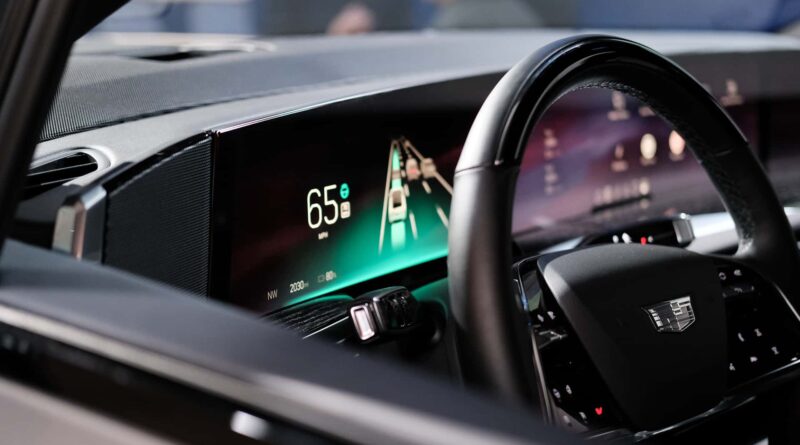GM Super Cruise aims to beat Tesla in 2028 with LIDAR, eyes-free driving
- General Motors announced today at its GM Forward event that it plans Super Cruise to enable eyes-free driving by 2028.
- Currently, Super Cruise enables hands-free driving on more than 750,000 miles of compatible highways in the United States and Canada. This update would be one step closer to much deeper autonomous driving assistance.
- Tesla’s Autopilot and fully autonomous driving require the driver to keep his eyes on the road. Only Mercedes-Benz offers a comparable system, but it is much more limited.
Super Cruise was an objective victory for General Motors. The automated driving assistance system, which allows you to take your hands off the wheel while watching the car and the road ahead, continues to gain millions of subscribers after its trial period ends.
At its GM Forward event in New York on Wednesday, the automaker had to say to all those users: You ain’t seen nothing yet. And soon seeing the road ahead may not even be a requirement.
GM plans to add an “eyes-free” feature to Super Cruise by 2028, the company said, meaning users will be able to take their hands off the wheel but no longer have to focus on the road when the system is on. The feature will debut on the Cadillac Escalade IQ — and that means the current model, not the new one, a GM spokesperson confirmed. This would be a true Level 3 advanced driver assistance system, a step up from the Level 2 system that currently defines Super Cruise and virtually all other systems in the US.
The Escalade IQ does so by adding LIDAR, or light-based radar, making it a significant technological leap over the current system based on cameras, radars and GPS. This system will then be expanded to more GM models very quickly, CEO Mary Barra said at the event.
“We have (standard Super Cruise) on 23 models now, and we did it pretty quickly as soon as we could,” Barra said, adding that the pandemic-related chip shortage has slowed his pace. “This is something you’ll see us rolling much, much faster than Super Cruise.”
GM officials did not disclose which company supplies its LIDAR array. It also doesn’t say what that increased level of Super Cruise might cost, or what an eventual equipment package might cost on the Escalade IQ. But over time, GM’s autonomous technology will also move off the highways.
“From there, we’ll expand into the urban environment, eventually allowing your vehicle to run errands while you focus on more important things,” said Sterling Anderson, GM’s chief product officer. “We’re going to build incrementally and deploy safely because we know it works. It’s the only way it works.”
Additionally, GM’s senior vice president of software and service engineering, Dave Richardson, said it’s a big step toward the automaker’s ultimate goal of full autonomy. “This locks the way from today’s hands-free driving to tomorrow’s eyes-free driving and ultimately to a future where the car drives itself,” he said.
When driving the Escalade IQ without eyes, turquoise lights appear on the dashboard and side mirrors. This allows for visual guidance for drivers and pedestrians outside the vehicle, GM said. They may also notice a bump in the Escalade IQ’s LIDAR sensor in the center of the roof.
GM officials said its users have now driven more than 700 million miles on mapped highways with Super Cruise. But it will soon add “technology and validation frameworks from Cruise,” its now-defunct robotaxi service, adding another 5 million kilometers of experience to the system.
However, GM officials have not confirmed whether the eyes-free Super Cruise will work on all the same highways as the standard system.
Currently, activating Super Cruise on a number of GM vehicles triggers a green bar on the steering wheel to let you know it can handle highway driving. A camera and infrared LEDs are then used to track the driver’s head position and gaze, ensuring they are not on their phone or reading a book or ready to strike. Additional features include lane centering, automatic lane changes and hands-free trailering.
Tesla’s camera autopilot and fully autonomous driving systems steer the car along the road and also require the driver’s full attention. Tesla issues a warning or possibly disconnects the system if it doesn’t. If GM can implement this system on a large scale, it will be a leap from what Tesla is doing — at least what it’s doing in 2025.
With this announcement, GM was apparently addressing Tesla’s camera-only approach to ADAS.
“Unlike vision-only systems, GM’s approach is built on redundancy with LIDAR, radar and cameras integrated into the vehicle design,” the automaker said. “The core is sensor fusion: LIDAR, radar, and cameras form the perception layer; real-world driving data trains the decision-making model; and high-fidelity simulation verifies performance in rare or dangerous scenarios. This provides a safe, reliable, and highly capable vision-off autonomous system.”
A true hands-free steering system is currently only offered by Mercedes-Benz. But that system, Drive Pilot, only works in California or Nevada, during the day in clear weather, only on approved highways, and only below 40 mph.
Mercedes officials said the expansion of its system is limited by the lack of a national law governing autonomous cars in America. As for how GM plans to overcome the issue, Anderson was cautious. “Some states are open, some are not,” he said. “Right now, we’re going to take it as we go.
Contact the author: patrick.george@insideevs.com
